Introduction
Jambalaya is more than just a dish; it’s a celebration of culture, history, and flavor that hails from the heart of Louisiana. This traditional Creole dish is known for its vibrant blend of spices, meats, and vegetables, making it a beloved staple in Southern cooking. Originating in New Orleans, jambalaya has become synonymous with gatherings and festivities, often served at family reunions, parties, and community events. It brings people together over a shared love for hearty, home-cooked meals.
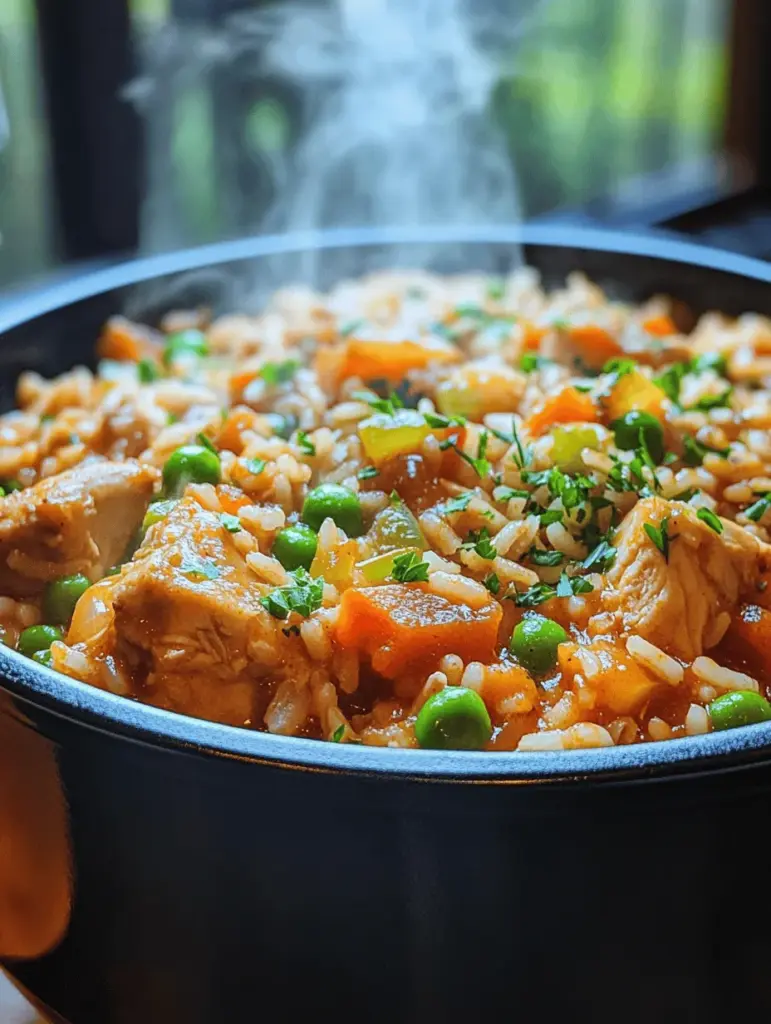
In recent years, the convenience of slow cookers has transformed how we prepare and enjoy this classic dish. The slow cooker allows for an effortless cooking experience, letting the flavors meld beautifully over time without requiring constant supervision. Imagine coming home after a long day to the inviting aroma of savory chicken jambalaya wafting through your home—a perfect end to any busy day.
This Savory Slow Cooker Chicken Jambalaya recipe embodies the essence of traditional jambalaya while simplifying the cooking process. With its simple ingredients and straightforward preparation, even novice cooks can create a dish that is both satisfying and flavorful. Get ready to explore a delightful culinary adventure that brings the taste of Louisiana right to your kitchen.
Understanding Jambalaya
To truly appreciate the beauty of jambalaya, one must delve into its rich history and cultural significance. Jambalaya has roots in Spanish, French, and African cuisines, reflecting the diverse influences that have shaped Louisiana’s food culture. It is believed to have originated from the Spanish dish paella, with the early settlers adapting it to include local ingredients. Over the years, jambalaya has evolved into two primary styles: Creole and Cajun.
Creole vs. Cajun
Creole jambalaya typically features a mixture of meats, including chicken, sausage, and seafood, with a rich tomato base. It is often referred to as “red jambalaya” due to its vibrant color. On the other hand, Cajun jambalaya, sometimes called “brown jambalaya,” relies on a darker roux and generally includes chicken and sausage without tomatoes. Both variations are delicious in their own right, showcasing the unique flavors of Louisiana cuisine.
Key Ingredients That Define Jambalaya
At its core, jambalaya is defined by its balance of proteins, vegetables, and spices. The key ingredients include:
- Proteins: While chicken is a staple, jambalaya can also include sausage, shrimp, or other meats, adding depth and flavor.
- Vegetables: The holy trinity of Cajun and Creole cooking—onion, bell pepper, and celery—forms the base of the dish. Garlic also plays a pivotal role, enhancing the overall flavor.
- Tomatoes: Canned tomatoes contribute a rich acidity that balances the dish’s savory elements.
- Broth and Rice: Chicken broth (or stock) is essential for cooking the rice, imparting flavor and moisture to the dish.
- Spices: Cajun seasoning and dried thyme are crucial in creating the distinctive flavor profile, while bay leaves add an aromatic touch.
Essential Ingredients for Savory Slow Cooker Chicken Jambalaya
Now that we have a foundational understanding of jambalaya, let’s explore the essential ingredients that make this Savory Slow Cooker Chicken Jambalaya a must-try recipe.
Overview of the Main Ingredients
This recipe focuses on boneless, skinless chicken thighs, which are perfect for slow cooking due to their tender texture and rich flavor. Chicken thighs hold up well during the cooking process, absorbing the seasonings and moisture from the broth.
The vegetables used in this recipe include onion, bell pepper, celery, and garlic. This combination not only adds a delightful crunch but also enhances the overall flavor profile. The natural sweetness of sautéed onions and bell peppers pairs beautifully with the savory notes of the chicken and spices.
Canned tomatoes are a vital component in this dish, providing acidity and richness. They contribute to the dish’s overall texture and serve as a base for the other ingredients, allowing them to meld together harmoniously as they cook.
Chicken broth is another key ingredient that ensures the rice cooks perfectly while infusing the dish with flavor. The rice acts as a filler, absorbing the juices and creating a satisfying, hearty meal. For this recipe, long-grain white rice is recommended, as it cooks evenly and maintains a good texture.
Importance of Using Boneless, Skinless Chicken Thighs
While chicken breast is often considered a healthier option, boneless, skinless chicken thighs are recommended for this jambalaya recipe for several reasons. First, they are more flavorful due to their higher fat content, which lends a richness to the dish. Second, they remain juicy and tender even after prolonged cooking, making them ideal for slow-cooked meals. The thighs absorb spices and other flavors beautifully, resulting in a more robust and satisfying dish.
The Role of Vegetables: Onion, Bell Pepper, Celery, and Garlic
The combination of onion, bell pepper, and celery is a cornerstone of many Cajun and Creole dishes. Known as the holy trinity, this trio of vegetables adds depth and complexity to jambalaya. The onion provides sweetness, while the bell pepper adds color and a slight crunch. Celery contributes a fresh, herbaceous note that balances the dish.
Garlic, often added to the mix, enhances flavor and aroma. It should be minced finely to ensure it disperses evenly throughout the dish, ensuring every bite is infused with its distinctive taste.
How Canned Tomatoes Contribute to the Dish’s Flavor Profile
Canned tomatoes, whether diced or crushed, bring a vital acidity to the dish. They not only provide a juicy base for the jambalaya but also help to balance out the richness of the chicken and seasoning. When simmered slowly, the tomatoes break down and meld with the other ingredients, creating a harmonious sauce that coats the rice.
The Significance of Chicken Broth and Rice in Achieving the Perfect Texture
Chicken broth is essential for cooking the rice and infusing it with flavor. It adds moisture and depth, enhancing the overall taste of the dish. When cooking jambalaya, the ratio of liquid to rice is crucial; too much liquid can lead to mushy rice, while too little can leave it undercooked. For this slow cooker recipe, we maintain the perfect balance to achieve a fluffy and well-cooked rice that absorbs all the delicious flavors.
Long-grain white rice is recommended for jambalaya because it cooks evenly and retains its texture. It plumps up beautifully as it absorbs the broth, resulting in a satisfying, hearty meal.
Explanation of Cajun Seasoning and Dried Thyme; Their Flavor Contributions
Cajun seasoning is a blend of spices that brings the authentic taste of Louisiana to your jambalaya. It typically includes ingredients like paprika, cayenne pepper, garlic powder, onion powder, and black pepper. This seasoning adds warmth and complexity to the dish, infusing the chicken and vegetables with a rich, bold flavor.
Dried thyme is another important herb that complements the spices in Cajun seasoning. Its earthy notes enhance the overall flavor profile of the jambalaya, adding a subtle aromatic quality that ties the dish together.
The Role of Bay Leaves and Peas in Enhancing the Dish
Bay leaves are a classic addition to many slow-cooked dishes, and jambalaya is no exception. These leaves add a subtle depth of flavor and aroma as they simmer in the broth. They should be removed before serving, as they are not meant to be consumed whole.
Peas can be added towards the end of the cooking process, providing a pop of color and a touch of sweetness. They complement the other ingredients while adding a nutritional boost, making the dish even more satisfying and wholesome.
Step-by-Step Instructions
Now that we have covered the essential ingredients for Savory Slow Cooker Chicken Jambalaya, it’s time to dive into the preparation process. The following step-by-step instructions will guide you through creating this flavorful dish with ease.
Preparation of Ingredients
1. Gather Your Ingredients: Start by collecting all the ingredients needed for the recipe. This includes boneless, skinless chicken thighs, onion, bell pepper, celery, garlic, canned tomatoes, chicken broth, long-grain white rice, Cajun seasoning, dried thyme, bay leaves, and frozen peas.
2. Chop the Vegetables: Dice the onion, bell pepper, and celery into small, uniform pieces to ensure even cooking. Mince the garlic finely so that it can infuse its flavor throughout the dish.
3. Prepare the Chicken: Cut the boneless, skinless chicken thighs into bite-sized pieces. This helps them cook evenly and allows the spices to penetrate the meat fully.
Tips on Chopping Vegetables and Dicing Chicken
- When chopping vegetables, use a sharp knife for clean cuts. A dull knife can mash the vegetables, affecting their texture.
- For even-sized chicken pieces, try to cut them into similar sizes, ensuring they cook at the same rate. This prevents some pieces from being overcooked while others remain undercooked.
Layering Ingredients in the Slow Cooker
1. Layer the Vegetables: Start by placing the chopped onion, bell pepper, celery, and minced garlic at the bottom of the slow cooker. This forms a flavorful base for the chicken and rice.
2. Add the Chicken: Next, layer the diced chicken thighs over the vegetables. This allows the juices from the chicken to seep into the vegetables as they cook.
3. Incorporate the Tomatoes and Broth: Pour in the canned tomatoes along with their juices, followed by the chicken broth. Stir gently to combine the ingredients.
4. Add Seasonings and Rice: Sprinkle in the Cajun seasoning, dried thyme, and bay leaves. Finally, add the long-grain white rice, making sure it is evenly distributed throughout the mixture.
5. Cover and Cook: Secure the lid on your slow cooker and set it to cook on low for 6 to 8 hours or on high for 3 to 4 hours. This slow cooking process allows the flavors to meld and the rice to absorb the delicious broth.
As your Savory Slow Cooker Chicken Jambalaya simmers, the delightful aroma will fill your kitchen, enticing everyone to gather around the table. With each step, you are creating a dish that not only satisfies hunger but also evokes the warmth and spirit of Louisiana’s culinary traditions. Stay tuned for the next part, where we will explore additional tips for achieving the best results and answer some common questions about this classic dish.
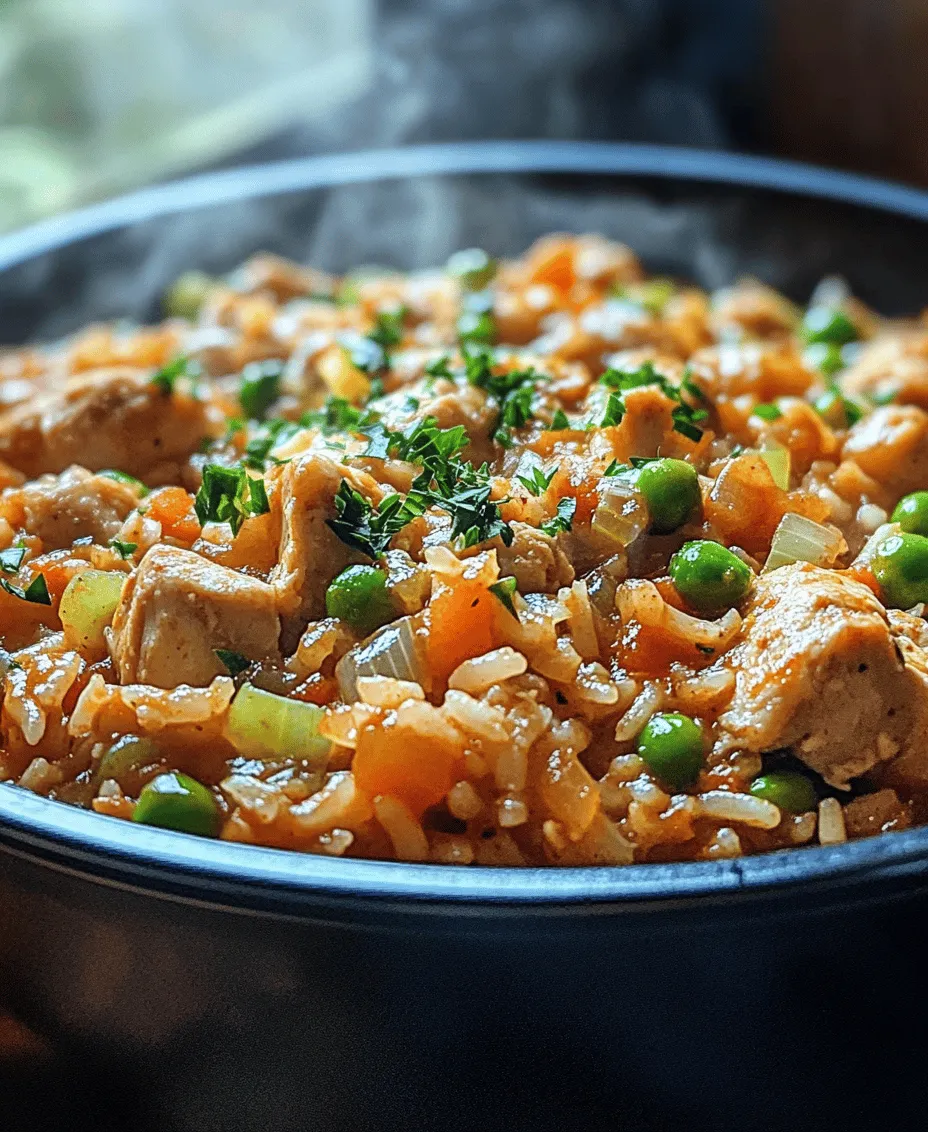
Importance of the Order of Adding Ingredients
When preparing Savory Slow Cooker Chicken Jambalaya, the order in which ingredients are added can significantly impact the overall flavor and texture of the dish. Start by layering your ingredients wisely; this helps ensure that all flavors meld beautifully over the slow cooking process. Begin with the base ingredients: the chicken, onions, bell peppers, and celery (known as the “holy trinity” in Cajun cooking). These ingredients should go in first since they need the longest cooking time to soften and release their flavors into the broth.
Next, add your garlic, spices, and any canned tomatoes or tomato paste. These ingredients should be added after the base to prevent the garlic from burning and the spices from becoming overly cooked. Finally, stir in the rice and broth, ensuring that everything is well mixed. This order preserves the integrity of each ingredient, allowing them to shine in the final dish while creating a harmonious blend of flavors.
Cooking Methods: Low vs. High
The beauty of cooking Jambalaya in a slow cooker is the flexibility it offers. You can choose to cook on low for 6-8 hours or on high for 3-4 hours. Cooking on low allows for a more gradual infusion of flavors, making the dish even richer and more complex. It’s ideal if you’re preparing the meal early in the day and want to enjoy it for dinner without any last-minute hassle.
On the other hand, cooking on high is perfect for those who may not have as much time but still want to enjoy this delicious dish. While the flavor may not develop as deeply as it would on low, it still results in a hearty and satisfying meal. Whichever method you choose, the slow cooking process ensures that the chicken remains tender and juicy, absorbing all the spice and flavor from the other ingredients.
Benefits of Slow Cooking for Flavor Development
Slow cooking is a game-changer when it comes to developing deep, rich flavors in dishes like Chicken Jambalaya. The extended cooking time allows spices to fully bloom and meld, creating a symphony of flavors that are hard to achieve through quicker cooking methods. As the chicken cooks slowly, it breaks down and releases its juices, which combine with the other ingredients to create a mouthwatering broth.
Moreover, slow cooking helps the vegetables retain their nutrients while also softening them, ensuring they blend seamlessly with the rice and chicken. This method also minimizes the need for added fats because the natural moisture from the ingredients keeps everything tender and flavorful. Overall, slow cooking is an excellent technique for maximizing the taste and nutritional content of your meals.
Final Touches Before Serving: Stirring in Frozen Peas
Just before serving your Jambalaya, add a cup of frozen peas to the slow cooker. The bright green peas not only add a pop of color to the dish but also bring a subtle sweetness that balances the savory flavors. Stir them in during the last 10-15 minutes of cooking to ensure they heat through without becoming mushy. This final touch elevates the dish, providing a delightful contrast in texture and a boost in nutritional value.
Guidance on Seasoning Adjustments
Seasoning is key to any great dish, and Jambalaya is no exception. As you prepare your chicken Jambalaya, taste the dish about halfway through the cooking process. This is a good time to adjust the seasoning. Depending on your preferences and the saltiness of your broth, you may want to add more salt, pepper, or cayenne for heat.
If you find the dish a bit too spicy, consider adding a dollop of sour cream or yogurt when serving to balance the heat. For a fresh twist, a squeeze of lime or lemon juice can brighten up the flavors. Remember, the goal is to create a dish that suits your palate while highlighting the traditional flavors of Louisiana cuisine.
Nutritional Benefits of Chicken Jambalaya
Overview of the Nutritional Content of the Main Ingredients
Savory Slow Cooker Chicken Jambalaya is not only delicious but also packed with nutrients. The primary ingredients—chicken, rice, and vegetables—offer a well-rounded meal. Chicken is an excellent source of lean protein, essential for muscle repair and growth. Brown rice provides complex carbohydrates, which are crucial for sustained energy levels, while the colorful veggies contribute vitamins, minerals, and dietary fiber.
Health Benefits of Using Lean Chicken and Fresh Vegetables
By using lean chicken breast, you significantly lower the fat content of the dish, making it a healthier option compared to traditional recipes that may include sausage or higher-fat proteins. Fresh vegetables like bell peppers, onions, and celery are rich in vitamins A and C, antioxidants, and dietary fiber, which aid in digestion and support overall health.
Additionally, the spices commonly used in Jambalaya, such as paprika and cayenne pepper, may have health benefits, including anti-inflammatory properties. This balance of lean protein, whole grains, and colorful vegetables makes Jambalaya a nutritious choice for families looking to enjoy a hearty meal.
Balancing Flavors and Nutrition in a Family-Friendly Meal
One of the best aspects of Jambalaya is its versatility, making it easy to adjust ingredients to cater to different dietary needs or preferences. You can add more vegetables or swap out the chicken for shrimp or tofu to create a vegetarian version. By balancing flavors and nutrition, this dish can easily become a family favorite that pleases everyone’s palate while providing essential nutrients.
Serving Suggestions and Pairings
Ideas for Side Dishes That Complement Jambalaya
Jambalaya is a complete meal on its own, but if you’re looking to enhance your dining experience, consider serving it with some complementary side dishes. A simple green salad with a citrus vinaigrette adds a refreshing contrast to the richness of the Jambalaya. Other great options include cornbread or crusty French bread, perfect for soaking up any remaining broth.
For a more Southern touch, serve your Jambalaya with collard greens or roasted Brussels sprouts. These sides not only add freshness but also bring additional nutrients to the table.
Recommendations for Beverages to Serve with the Dish
When it comes to beverages, Jambalaya pairs beautifully with a variety of options. A crisp white wine, such as Sauvignon Blanc or a light-bodied red like Pinot Noir, can complement the dish’s spices without overpowering them. If you prefer non-alcoholic beverages, sweet tea or lemonade works wonderfully, providing a refreshing balance to the savory flavors.
Creative Serving Ideas for Gatherings or Family Dinners
For gatherings or family dinners, consider serving Jambalaya in individual bowls for a more personalized touch. You can also set up a Jambalaya bar with toppings like diced green onions, hot sauce, and fresh herbs, allowing guests to customize their portions. This interactive approach not only makes for a fun dining experience but also encourages everyone to engage with the meal.
Storing and Reheating Leftovers
Best Practices for Storing Jambalaya
If you find yourself with leftovers, storing Jambalaya properly allows you to enjoy this delicious dish again. Allow the Jambalaya to cool completely before transferring it to an airtight container. It can be stored in the refrigerator for up to 3-4 days or frozen for up to 3 months. When freezing, consider portioning it into individual servings for easy reheating later.
Tips for Reheating to Maintain Flavor and Texture
Reheating Jambalaya can be done in several ways. For the best results, reheat it on the stove over low heat, adding a splash of broth or water to maintain moisture. Stir occasionally to ensure even heating and prevent the rice from sticking to the bottom of the pot. If using a microwave, heat in short intervals, stirring in between, until the dish is heated through.
Creative Ways to Repurpose Leftovers (e.g., Wraps, Salads)
Leftover Jambalaya can be creatively repurposed into new meals. Try using it as a filling for wraps or burritos, adding some avocado and cheese for extra flavor. Alternatively, mix it with fresh greens to create a hearty salad, or use it as a topping for baked potatoes for a unique twist.
Conclusion
Savory Slow Cooker Chicken Jambalaya captures the essence of Louisiana cuisine with its rich flavors and hearty ingredients. This dish is not only convenient to prepare but also versatile, allowing for various adaptations that cater to personal tastes and dietary needs. The benefits of slow cooking enhance the flavor development, while the balance of protein, vegetables, and spices ensures a nutritious meal for the entire family.
We encourage you to try this recipe and bring a taste of Louisiana to your kitchen. Not only will you enjoy the delicious flavors, but you’ll also create memorable moments as you gather around the table with loved ones, sharing a meal made with care and love. Cooking is a joy that brings people together, and with dishes like Jambalaya, you can create lasting memories one bite at a time.
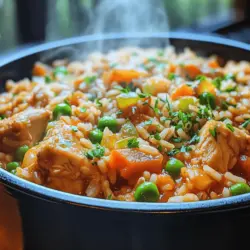

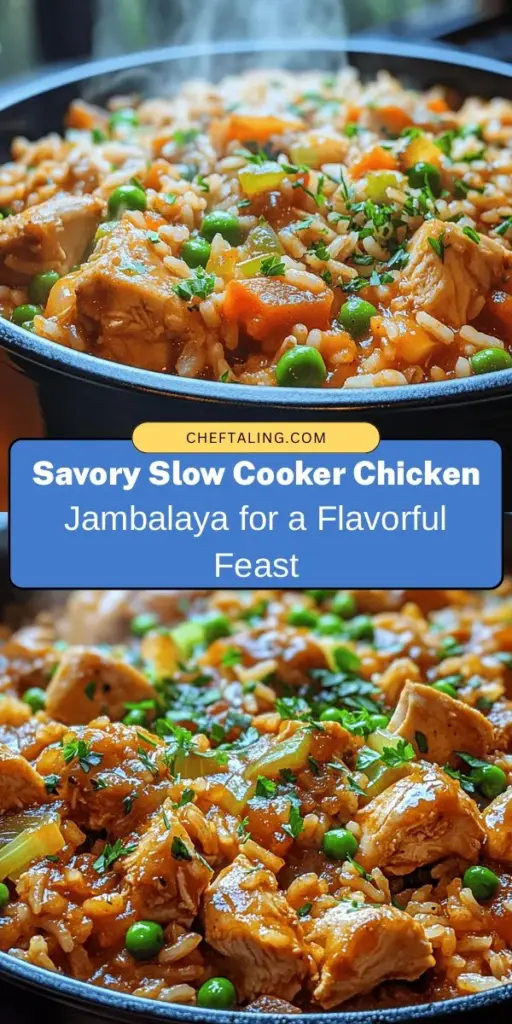

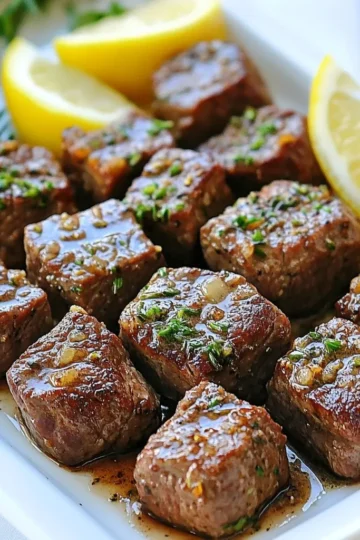
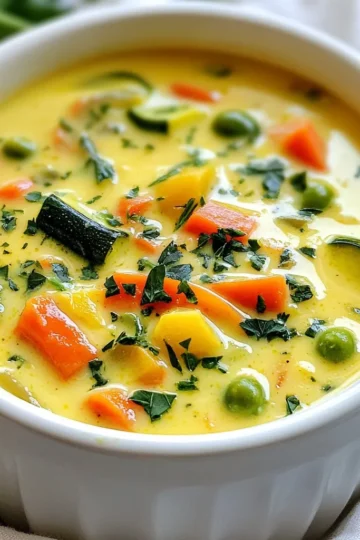
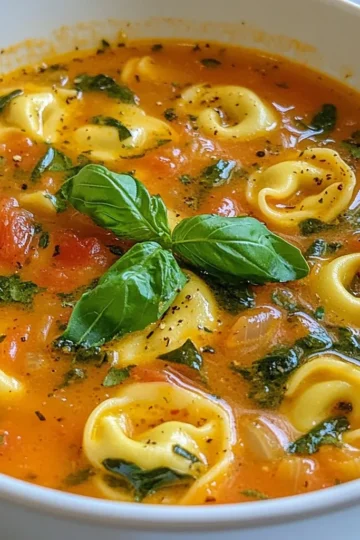
Leave a Reply